Research on Smart Cities and Urbanization Challenges
VerifiedAdded on 2023/06/08
|22
|6438
|218
Report
AI Summary
This report delves into the critical relationship between smart cities and the escalating challenges of urbanization. It begins by posing the research question of how smart cities can mitigate the negative impacts of increased urbanization. The research aims to assess the effects of urbanization and analyze the role of smart city initiatives in mitigating these challenges. The background of the study stems from the researcher's experience in the property development sector, which highlighted the growing importance of smart city projects. The report explores the challenges of urbanization, including infrastructure strain, resource scarcity, and potential social inequalities. The structure includes an introduction, literature review, methodology, data analysis, and conclusion. The literature review defines smart cities, examining their innovative use of technology and infrastructure. The report covers key components of smart infrastructure, including smart buildings, water management, and energy systems, highlighting how these elements can contribute to sustainable urban development. The report also explores how smart city initiatives address issues like pollution, poverty, and the efficient use of resources. The goal is to provide insights and recommendations for creating more sustainable and livable urban environments.
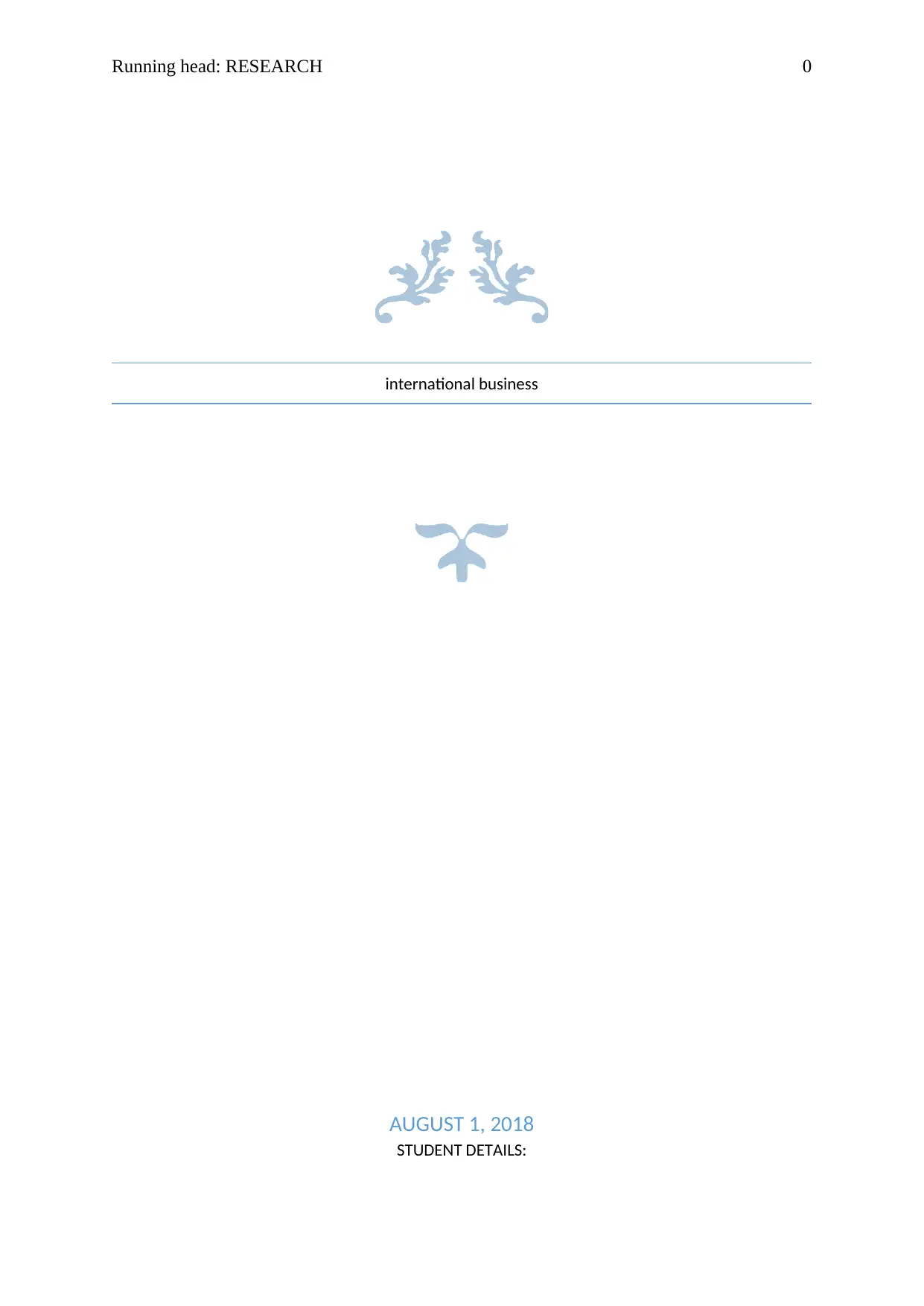
Running head: RESEARCH 0
international business
AUGUST 1, 2018
STUDENT DETAILS:
international business
AUGUST 1, 2018
STUDENT DETAILS:
Paraphrase This Document
Need a fresh take? Get an instant paraphrase of this document with our AI Paraphraser
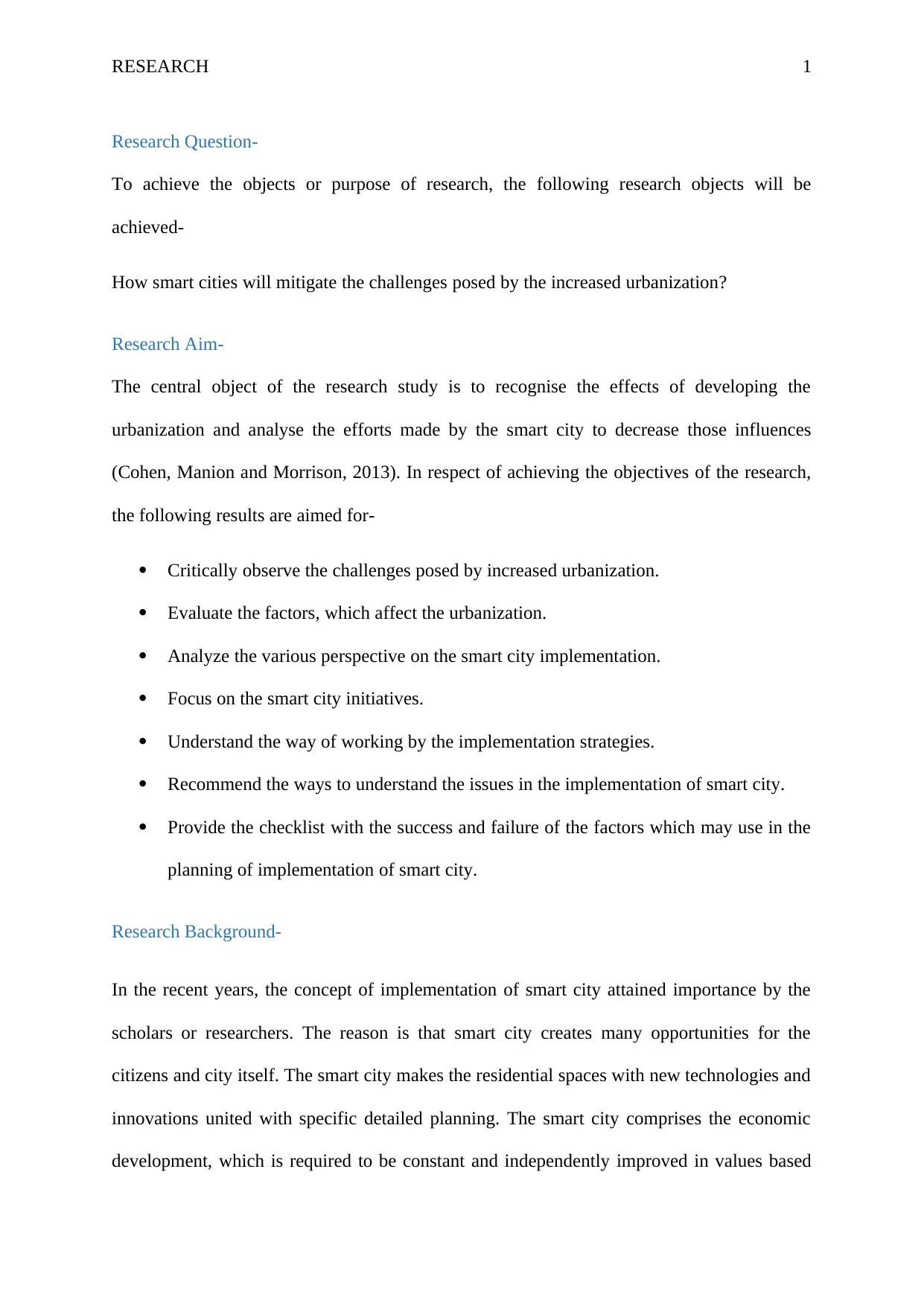
RESEARCH 1
Research Question-
To achieve the objects or purpose of research, the following research objects will be
achieved-
How smart cities will mitigate the challenges posed by the increased urbanization?
Research Aim-
The central object of the research study is to recognise the effects of developing the
urbanization and analyse the efforts made by the smart city to decrease those influences
(Cohen, Manion and Morrison, 2013). In respect of achieving the objectives of the research,
the following results are aimed for-
Critically observe the challenges posed by increased urbanization.
Evaluate the factors, which affect the urbanization.
Analyze the various perspective on the smart city implementation.
Focus on the smart city initiatives.
Understand the way of working by the implementation strategies.
Recommend the ways to understand the issues in the implementation of smart city.
Provide the checklist with the success and failure of the factors which may use in the
planning of implementation of smart city.
Research Background-
In the recent years, the concept of implementation of smart city attained importance by the
scholars or researchers. The reason is that smart city creates many opportunities for the
citizens and city itself. The smart city makes the residential spaces with new technologies and
innovations united with specific detailed planning. The smart city comprises the economic
development, which is required to be constant and independently improved in values based
Research Question-
To achieve the objects or purpose of research, the following research objects will be
achieved-
How smart cities will mitigate the challenges posed by the increased urbanization?
Research Aim-
The central object of the research study is to recognise the effects of developing the
urbanization and analyse the efforts made by the smart city to decrease those influences
(Cohen, Manion and Morrison, 2013). In respect of achieving the objectives of the research,
the following results are aimed for-
Critically observe the challenges posed by increased urbanization.
Evaluate the factors, which affect the urbanization.
Analyze the various perspective on the smart city implementation.
Focus on the smart city initiatives.
Understand the way of working by the implementation strategies.
Recommend the ways to understand the issues in the implementation of smart city.
Provide the checklist with the success and failure of the factors which may use in the
planning of implementation of smart city.
Research Background-
In the recent years, the concept of implementation of smart city attained importance by the
scholars or researchers. The reason is that smart city creates many opportunities for the
citizens and city itself. The smart city makes the residential spaces with new technologies and
innovations united with specific detailed planning. The smart city comprises the economic
development, which is required to be constant and independently improved in values based
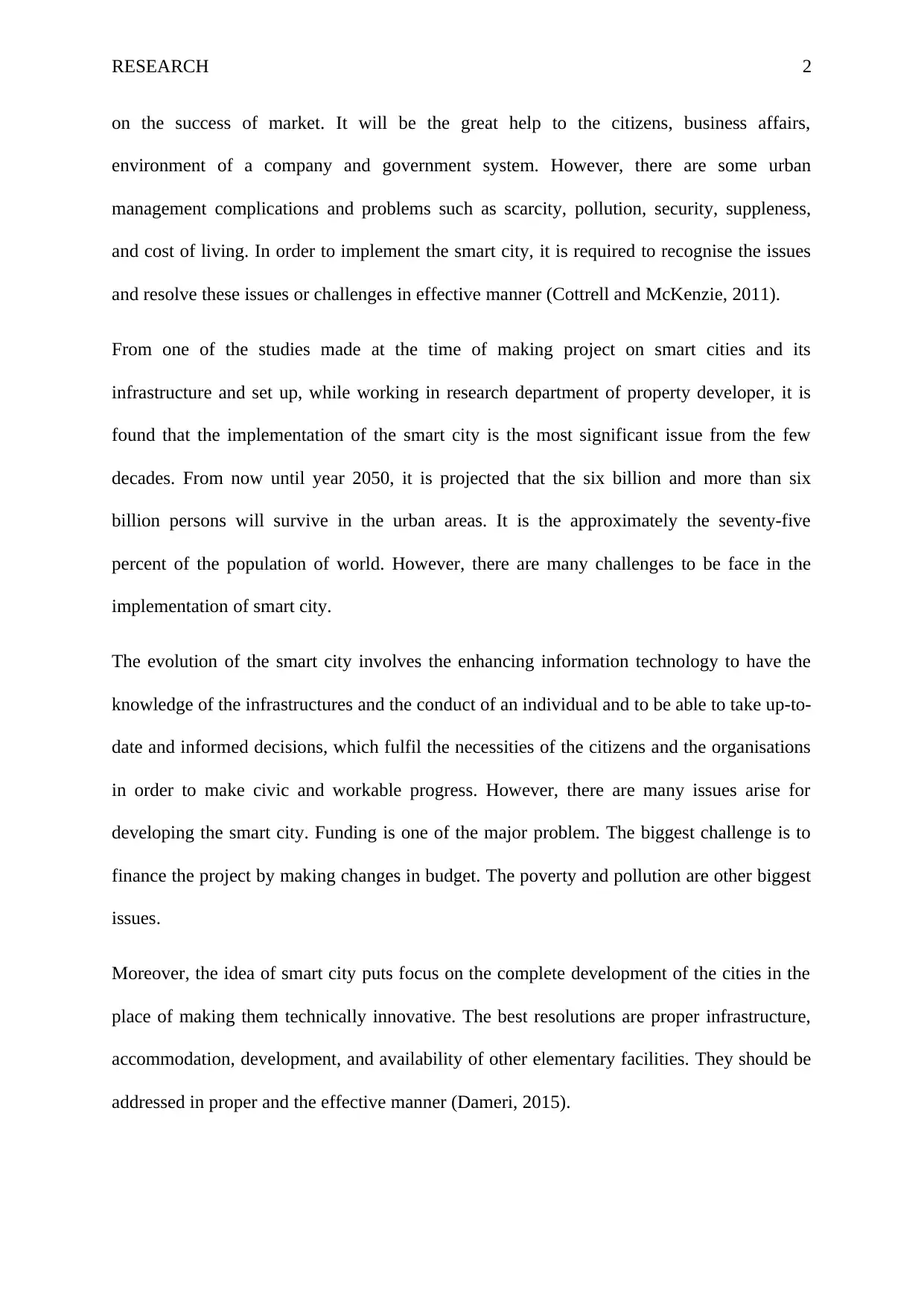
RESEARCH 2
on the success of market. It will be the great help to the citizens, business affairs,
environment of a company and government system. However, there are some urban
management complications and problems such as scarcity, pollution, security, suppleness,
and cost of living. In order to implement the smart city, it is required to recognise the issues
and resolve these issues or challenges in effective manner (Cottrell and McKenzie, 2011).
From one of the studies made at the time of making project on smart cities and its
infrastructure and set up, while working in research department of property developer, it is
found that the implementation of the smart city is the most significant issue from the few
decades. From now until year 2050, it is projected that the six billion and more than six
billion persons will survive in the urban areas. It is the approximately the seventy-five
percent of the population of world. However, there are many challenges to be face in the
implementation of smart city.
The evolution of the smart city involves the enhancing information technology to have the
knowledge of the infrastructures and the conduct of an individual and to be able to take up-to-
date and informed decisions, which fulfil the necessities of the citizens and the organisations
in order to make civic and workable progress. However, there are many issues arise for
developing the smart city. Funding is one of the major problem. The biggest challenge is to
finance the project by making changes in budget. The poverty and pollution are other biggest
issues.
Moreover, the idea of smart city puts focus on the complete development of the cities in the
place of making them technically innovative. The best resolutions are proper infrastructure,
accommodation, development, and availability of other elementary facilities. They should be
addressed in proper and the effective manner (Dameri, 2015).
on the success of market. It will be the great help to the citizens, business affairs,
environment of a company and government system. However, there are some urban
management complications and problems such as scarcity, pollution, security, suppleness,
and cost of living. In order to implement the smart city, it is required to recognise the issues
and resolve these issues or challenges in effective manner (Cottrell and McKenzie, 2011).
From one of the studies made at the time of making project on smart cities and its
infrastructure and set up, while working in research department of property developer, it is
found that the implementation of the smart city is the most significant issue from the few
decades. From now until year 2050, it is projected that the six billion and more than six
billion persons will survive in the urban areas. It is the approximately the seventy-five
percent of the population of world. However, there are many challenges to be face in the
implementation of smart city.
The evolution of the smart city involves the enhancing information technology to have the
knowledge of the infrastructures and the conduct of an individual and to be able to take up-to-
date and informed decisions, which fulfil the necessities of the citizens and the organisations
in order to make civic and workable progress. However, there are many issues arise for
developing the smart city. Funding is one of the major problem. The biggest challenge is to
finance the project by making changes in budget. The poverty and pollution are other biggest
issues.
Moreover, the idea of smart city puts focus on the complete development of the cities in the
place of making them technically innovative. The best resolutions are proper infrastructure,
accommodation, development, and availability of other elementary facilities. They should be
addressed in proper and the effective manner (Dameri, 2015).
⊘ This is a preview!⊘
Do you want full access?
Subscribe today to unlock all pages.

Trusted by 1+ million students worldwide
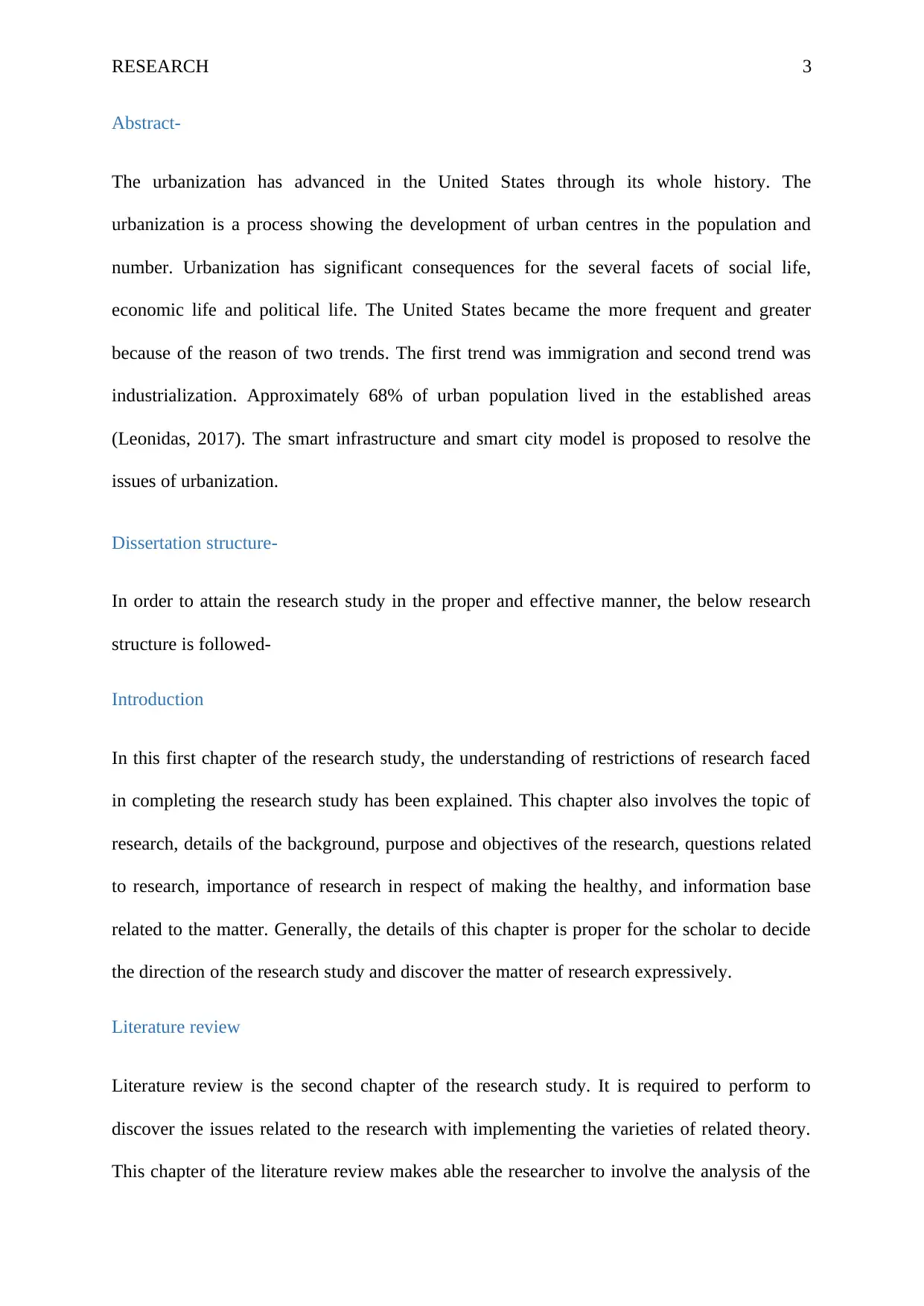
RESEARCH 3
Abstract-
The urbanization has advanced in the United States through its whole history. The
urbanization is a process showing the development of urban centres in the population and
number. Urbanization has significant consequences for the several facets of social life,
economic life and political life. The United States became the more frequent and greater
because of the reason of two trends. The first trend was immigration and second trend was
industrialization. Approximately 68% of urban population lived in the established areas
(Leonidas, 2017). The smart infrastructure and smart city model is proposed to resolve the
issues of urbanization.
Dissertation structure-
In order to attain the research study in the proper and effective manner, the below research
structure is followed-
Introduction
In this first chapter of the research study, the understanding of restrictions of research faced
in completing the research study has been explained. This chapter also involves the topic of
research, details of the background, purpose and objectives of the research, questions related
to research, importance of research in respect of making the healthy, and information base
related to the matter. Generally, the details of this chapter is proper for the scholar to decide
the direction of the research study and discover the matter of research expressively.
Literature review
Literature review is the second chapter of the research study. It is required to perform to
discover the issues related to the research with implementing the varieties of related theory.
This chapter of the literature review makes able the researcher to involve the analysis of the
Abstract-
The urbanization has advanced in the United States through its whole history. The
urbanization is a process showing the development of urban centres in the population and
number. Urbanization has significant consequences for the several facets of social life,
economic life and political life. The United States became the more frequent and greater
because of the reason of two trends. The first trend was immigration and second trend was
industrialization. Approximately 68% of urban population lived in the established areas
(Leonidas, 2017). The smart infrastructure and smart city model is proposed to resolve the
issues of urbanization.
Dissertation structure-
In order to attain the research study in the proper and effective manner, the below research
structure is followed-
Introduction
In this first chapter of the research study, the understanding of restrictions of research faced
in completing the research study has been explained. This chapter also involves the topic of
research, details of the background, purpose and objectives of the research, questions related
to research, importance of research in respect of making the healthy, and information base
related to the matter. Generally, the details of this chapter is proper for the scholar to decide
the direction of the research study and discover the matter of research expressively.
Literature review
Literature review is the second chapter of the research study. It is required to perform to
discover the issues related to the research with implementing the varieties of related theory.
This chapter of the literature review makes able the researcher to involve the analysis of the
Paraphrase This Document
Need a fresh take? Get an instant paraphrase of this document with our AI Paraphraser
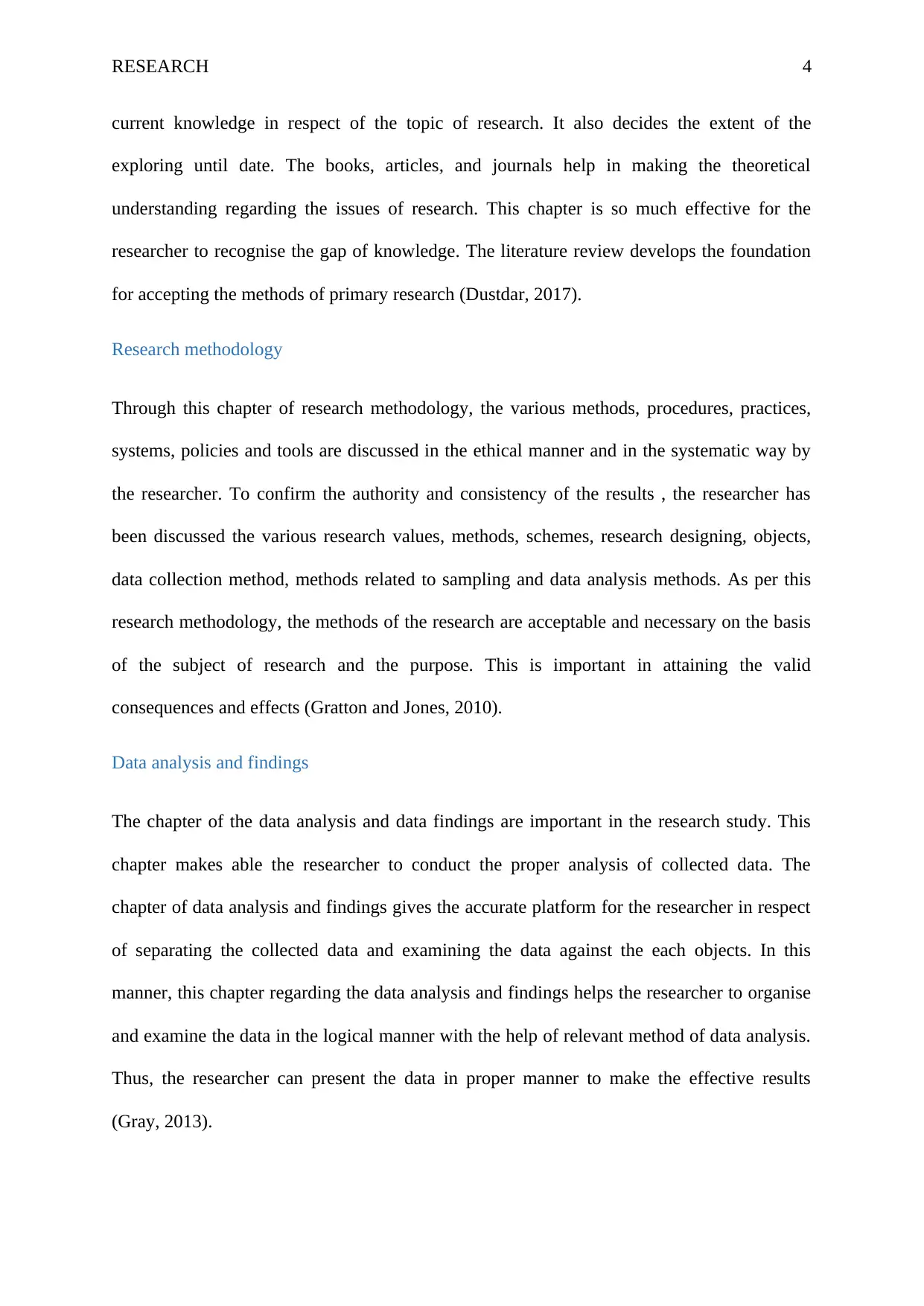
RESEARCH 4
current knowledge in respect of the topic of research. It also decides the extent of the
exploring until date. The books, articles, and journals help in making the theoretical
understanding regarding the issues of research. This chapter is so much effective for the
researcher to recognise the gap of knowledge. The literature review develops the foundation
for accepting the methods of primary research (Dustdar, 2017).
Research methodology
Through this chapter of research methodology, the various methods, procedures, practices,
systems, policies and tools are discussed in the ethical manner and in the systematic way by
the researcher. To confirm the authority and consistency of the results , the researcher has
been discussed the various research values, methods, schemes, research designing, objects,
data collection method, methods related to sampling and data analysis methods. As per this
research methodology, the methods of the research are acceptable and necessary on the basis
of the subject of research and the purpose. This is important in attaining the valid
consequences and effects (Gratton and Jones, 2010).
Data analysis and findings
The chapter of the data analysis and data findings are important in the research study. This
chapter makes able the researcher to conduct the proper analysis of collected data. The
chapter of data analysis and findings gives the accurate platform for the researcher in respect
of separating the collected data and examining the data against the each objects. In this
manner, this chapter regarding the data analysis and findings helps the researcher to organise
and examine the data in the logical manner with the help of relevant method of data analysis.
Thus, the researcher can present the data in proper manner to make the effective results
(Gray, 2013).
current knowledge in respect of the topic of research. It also decides the extent of the
exploring until date. The books, articles, and journals help in making the theoretical
understanding regarding the issues of research. This chapter is so much effective for the
researcher to recognise the gap of knowledge. The literature review develops the foundation
for accepting the methods of primary research (Dustdar, 2017).
Research methodology
Through this chapter of research methodology, the various methods, procedures, practices,
systems, policies and tools are discussed in the ethical manner and in the systematic way by
the researcher. To confirm the authority and consistency of the results , the researcher has
been discussed the various research values, methods, schemes, research designing, objects,
data collection method, methods related to sampling and data analysis methods. As per this
research methodology, the methods of the research are acceptable and necessary on the basis
of the subject of research and the purpose. This is important in attaining the valid
consequences and effects (Gratton and Jones, 2010).
Data analysis and findings
The chapter of the data analysis and data findings are important in the research study. This
chapter makes able the researcher to conduct the proper analysis of collected data. The
chapter of data analysis and findings gives the accurate platform for the researcher in respect
of separating the collected data and examining the data against the each objects. In this
manner, this chapter regarding the data analysis and findings helps the researcher to organise
and examine the data in the logical manner with the help of relevant method of data analysis.
Thus, the researcher can present the data in proper manner to make the effective results
(Gray, 2013).
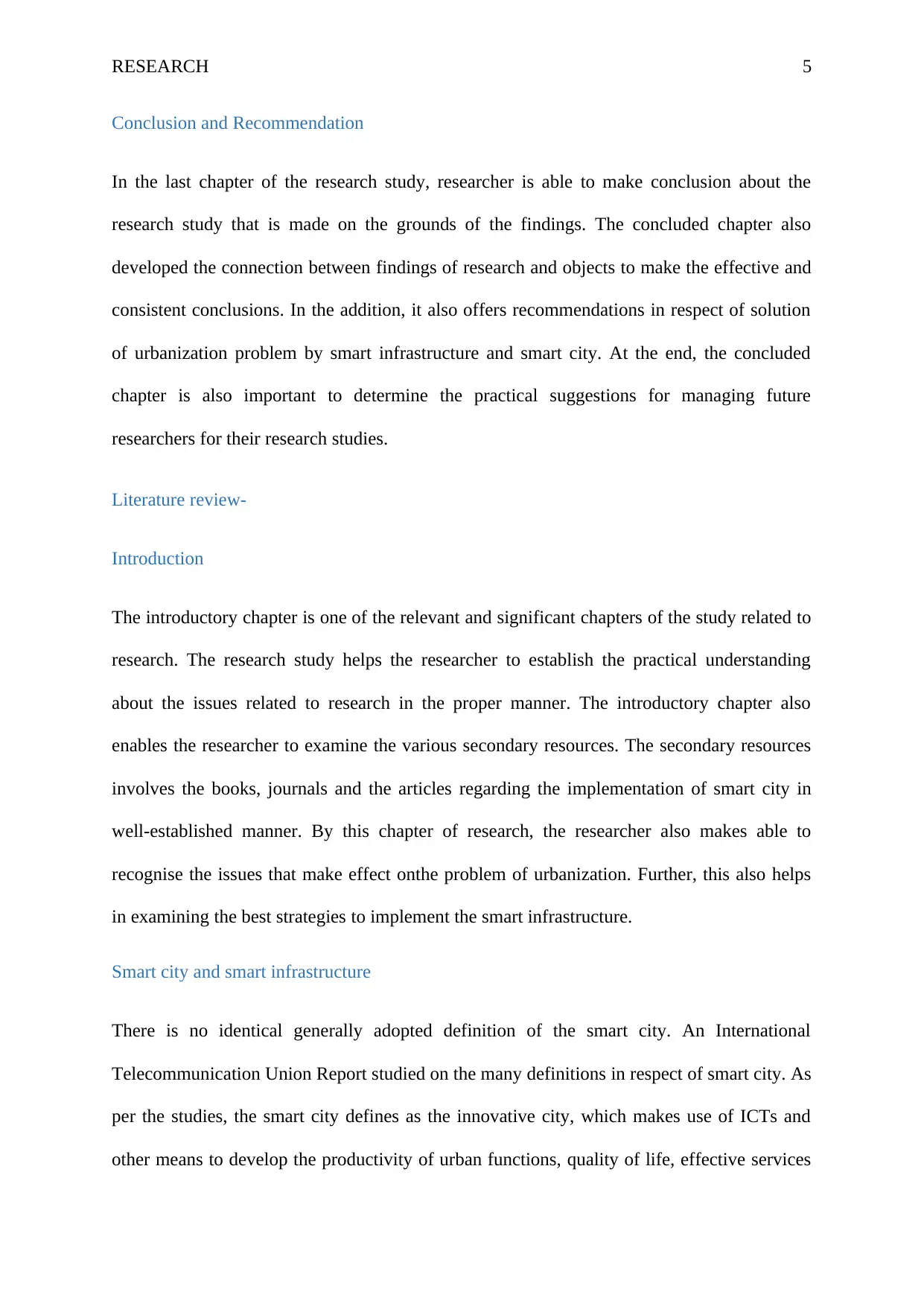
RESEARCH 5
Conclusion and Recommendation
In the last chapter of the research study, researcher is able to make conclusion about the
research study that is made on the grounds of the findings. The concluded chapter also
developed the connection between findings of research and objects to make the effective and
consistent conclusions. In the addition, it also offers recommendations in respect of solution
of urbanization problem by smart infrastructure and smart city. At the end, the concluded
chapter is also important to determine the practical suggestions for managing future
researchers for their research studies.
Literature review-
Introduction
The introductory chapter is one of the relevant and significant chapters of the study related to
research. The research study helps the researcher to establish the practical understanding
about the issues related to research in the proper manner. The introductory chapter also
enables the researcher to examine the various secondary resources. The secondary resources
involves the books, journals and the articles regarding the implementation of smart city in
well-established manner. By this chapter of research, the researcher also makes able to
recognise the issues that make effect onthe problem of urbanization. Further, this also helps
in examining the best strategies to implement the smart infrastructure.
Smart city and smart infrastructure
There is no identical generally adopted definition of the smart city. An International
Telecommunication Union Report studied on the many definitions in respect of smart city. As
per the studies, the smart city defines as the innovative city, which makes use of ICTs and
other means to develop the productivity of urban functions, quality of life, effective services
Conclusion and Recommendation
In the last chapter of the research study, researcher is able to make conclusion about the
research study that is made on the grounds of the findings. The concluded chapter also
developed the connection between findings of research and objects to make the effective and
consistent conclusions. In the addition, it also offers recommendations in respect of solution
of urbanization problem by smart infrastructure and smart city. At the end, the concluded
chapter is also important to determine the practical suggestions for managing future
researchers for their research studies.
Literature review-
Introduction
The introductory chapter is one of the relevant and significant chapters of the study related to
research. The research study helps the researcher to establish the practical understanding
about the issues related to research in the proper manner. The introductory chapter also
enables the researcher to examine the various secondary resources. The secondary resources
involves the books, journals and the articles regarding the implementation of smart city in
well-established manner. By this chapter of research, the researcher also makes able to
recognise the issues that make effect onthe problem of urbanization. Further, this also helps
in examining the best strategies to implement the smart infrastructure.
Smart city and smart infrastructure
There is no identical generally adopted definition of the smart city. An International
Telecommunication Union Report studied on the many definitions in respect of smart city. As
per the studies, the smart city defines as the innovative city, which makes use of ICTs and
other means to develop the productivity of urban functions, quality of life, effective services
⊘ This is a preview!⊘
Do you want full access?
Subscribe today to unlock all pages.

Trusted by 1+ million students worldwide
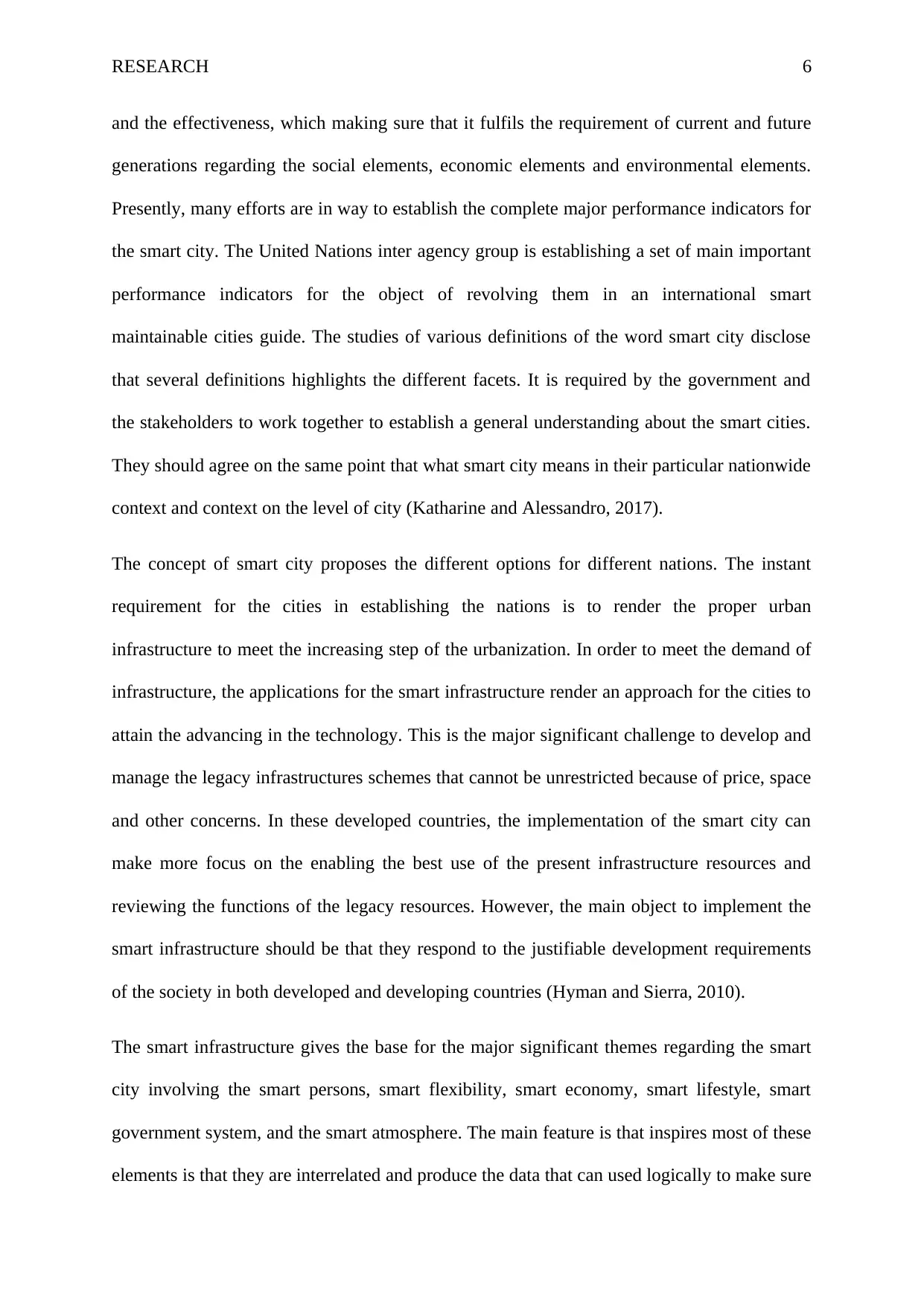
RESEARCH 6
and the effectiveness, which making sure that it fulfils the requirement of current and future
generations regarding the social elements, economic elements and environmental elements.
Presently, many efforts are in way to establish the complete major performance indicators for
the smart city. The United Nations inter agency group is establishing a set of main important
performance indicators for the object of revolving them in an international smart
maintainable cities guide. The studies of various definitions of the word smart city disclose
that several definitions highlights the different facets. It is required by the government and
the stakeholders to work together to establish a general understanding about the smart cities.
They should agree on the same point that what smart city means in their particular nationwide
context and context on the level of city (Katharine and Alessandro, 2017).
The concept of smart city proposes the different options for different nations. The instant
requirement for the cities in establishing the nations is to render the proper urban
infrastructure to meet the increasing step of the urbanization. In order to meet the demand of
infrastructure, the applications for the smart infrastructure render an approach for the cities to
attain the advancing in the technology. This is the major significant challenge to develop and
manage the legacy infrastructures schemes that cannot be unrestricted because of price, space
and other concerns. In these developed countries, the implementation of the smart city can
make more focus on the enabling the best use of the present infrastructure resources and
reviewing the functions of the legacy resources. However, the main object to implement the
smart infrastructure should be that they respond to the justifiable development requirements
of the society in both developed and developing countries (Hyman and Sierra, 2010).
The smart infrastructure gives the base for the major significant themes regarding the smart
city involving the smart persons, smart flexibility, smart economy, smart lifestyle, smart
government system, and the smart atmosphere. The main feature is that inspires most of these
elements is that they are interrelated and produce the data that can used logically to make sure
and the effectiveness, which making sure that it fulfils the requirement of current and future
generations regarding the social elements, economic elements and environmental elements.
Presently, many efforts are in way to establish the complete major performance indicators for
the smart city. The United Nations inter agency group is establishing a set of main important
performance indicators for the object of revolving them in an international smart
maintainable cities guide. The studies of various definitions of the word smart city disclose
that several definitions highlights the different facets. It is required by the government and
the stakeholders to work together to establish a general understanding about the smart cities.
They should agree on the same point that what smart city means in their particular nationwide
context and context on the level of city (Katharine and Alessandro, 2017).
The concept of smart city proposes the different options for different nations. The instant
requirement for the cities in establishing the nations is to render the proper urban
infrastructure to meet the increasing step of the urbanization. In order to meet the demand of
infrastructure, the applications for the smart infrastructure render an approach for the cities to
attain the advancing in the technology. This is the major significant challenge to develop and
manage the legacy infrastructures schemes that cannot be unrestricted because of price, space
and other concerns. In these developed countries, the implementation of the smart city can
make more focus on the enabling the best use of the present infrastructure resources and
reviewing the functions of the legacy resources. However, the main object to implement the
smart infrastructure should be that they respond to the justifiable development requirements
of the society in both developed and developing countries (Hyman and Sierra, 2010).
The smart infrastructure gives the base for the major significant themes regarding the smart
city involving the smart persons, smart flexibility, smart economy, smart lifestyle, smart
government system, and the smart atmosphere. The main feature is that inspires most of these
elements is that they are interrelated and produce the data that can used logically to make sure
Paraphrase This Document
Need a fresh take? Get an instant paraphrase of this document with our AI Paraphraser
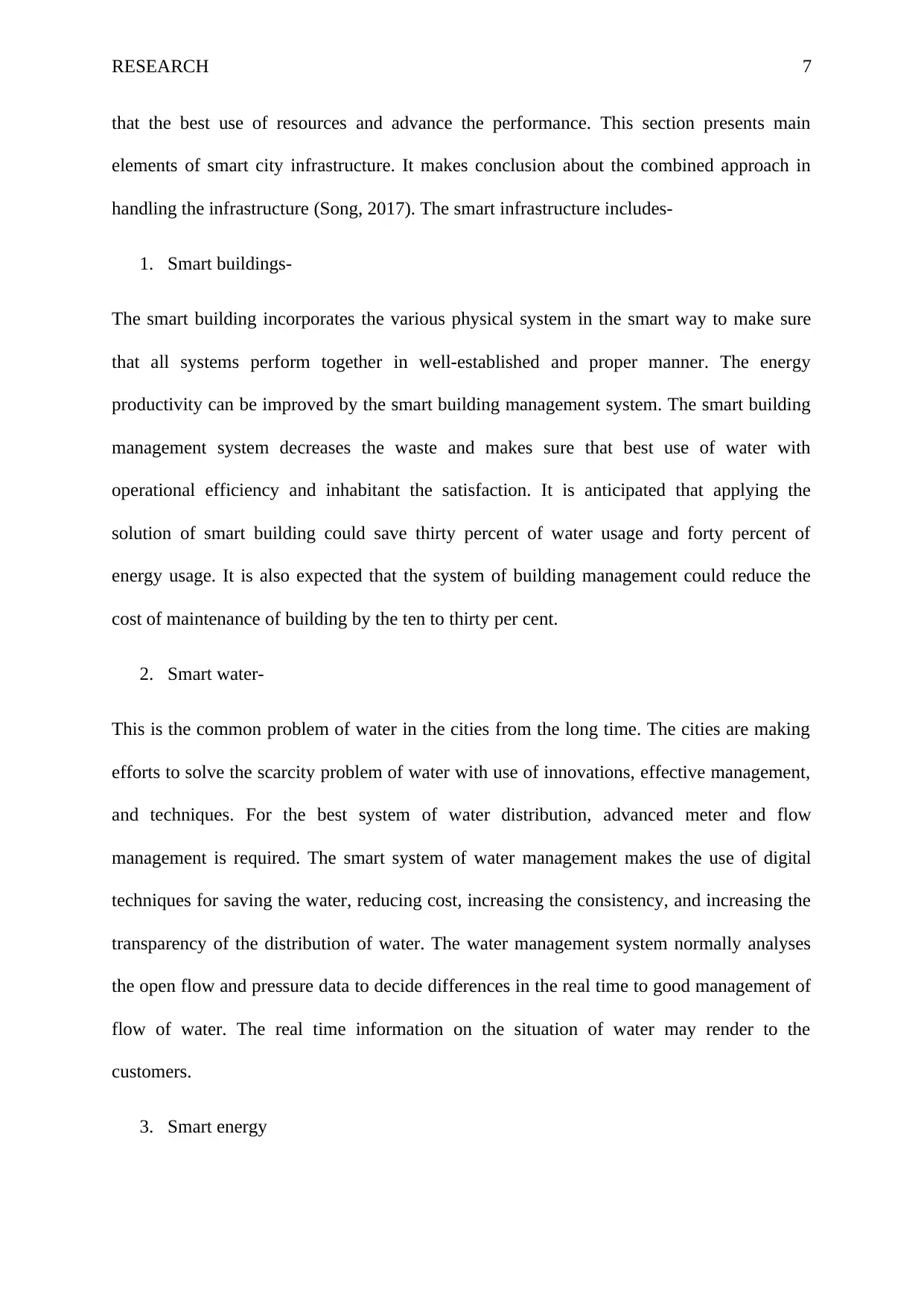
RESEARCH 7
that the best use of resources and advance the performance. This section presents main
elements of smart city infrastructure. It makes conclusion about the combined approach in
handling the infrastructure (Song, 2017). The smart infrastructure includes-
1. Smart buildings-
The smart building incorporates the various physical system in the smart way to make sure
that all systems perform together in well-established and proper manner. The energy
productivity can be improved by the smart building management system. The smart building
management system decreases the waste and makes sure that best use of water with
operational efficiency and inhabitant the satisfaction. It is anticipated that applying the
solution of smart building could save thirty percent of water usage and forty percent of
energy usage. It is also expected that the system of building management could reduce the
cost of maintenance of building by the ten to thirty per cent.
2. Smart water-
This is the common problem of water in the cities from the long time. The cities are making
efforts to solve the scarcity problem of water with use of innovations, effective management,
and techniques. For the best system of water distribution, advanced meter and flow
management is required. The smart system of water management makes the use of digital
techniques for saving the water, reducing cost, increasing the consistency, and increasing the
transparency of the distribution of water. The water management system normally analyses
the open flow and pressure data to decide differences in the real time to good management of
flow of water. The real time information on the situation of water may render to the
customers.
3. Smart energy
that the best use of resources and advance the performance. This section presents main
elements of smart city infrastructure. It makes conclusion about the combined approach in
handling the infrastructure (Song, 2017). The smart infrastructure includes-
1. Smart buildings-
The smart building incorporates the various physical system in the smart way to make sure
that all systems perform together in well-established and proper manner. The energy
productivity can be improved by the smart building management system. The smart building
management system decreases the waste and makes sure that best use of water with
operational efficiency and inhabitant the satisfaction. It is anticipated that applying the
solution of smart building could save thirty percent of water usage and forty percent of
energy usage. It is also expected that the system of building management could reduce the
cost of maintenance of building by the ten to thirty per cent.
2. Smart water-
This is the common problem of water in the cities from the long time. The cities are making
efforts to solve the scarcity problem of water with use of innovations, effective management,
and techniques. For the best system of water distribution, advanced meter and flow
management is required. The smart system of water management makes the use of digital
techniques for saving the water, reducing cost, increasing the consistency, and increasing the
transparency of the distribution of water. The water management system normally analyses
the open flow and pressure data to decide differences in the real time to good management of
flow of water. The real time information on the situation of water may render to the
customers.
3. Smart energy
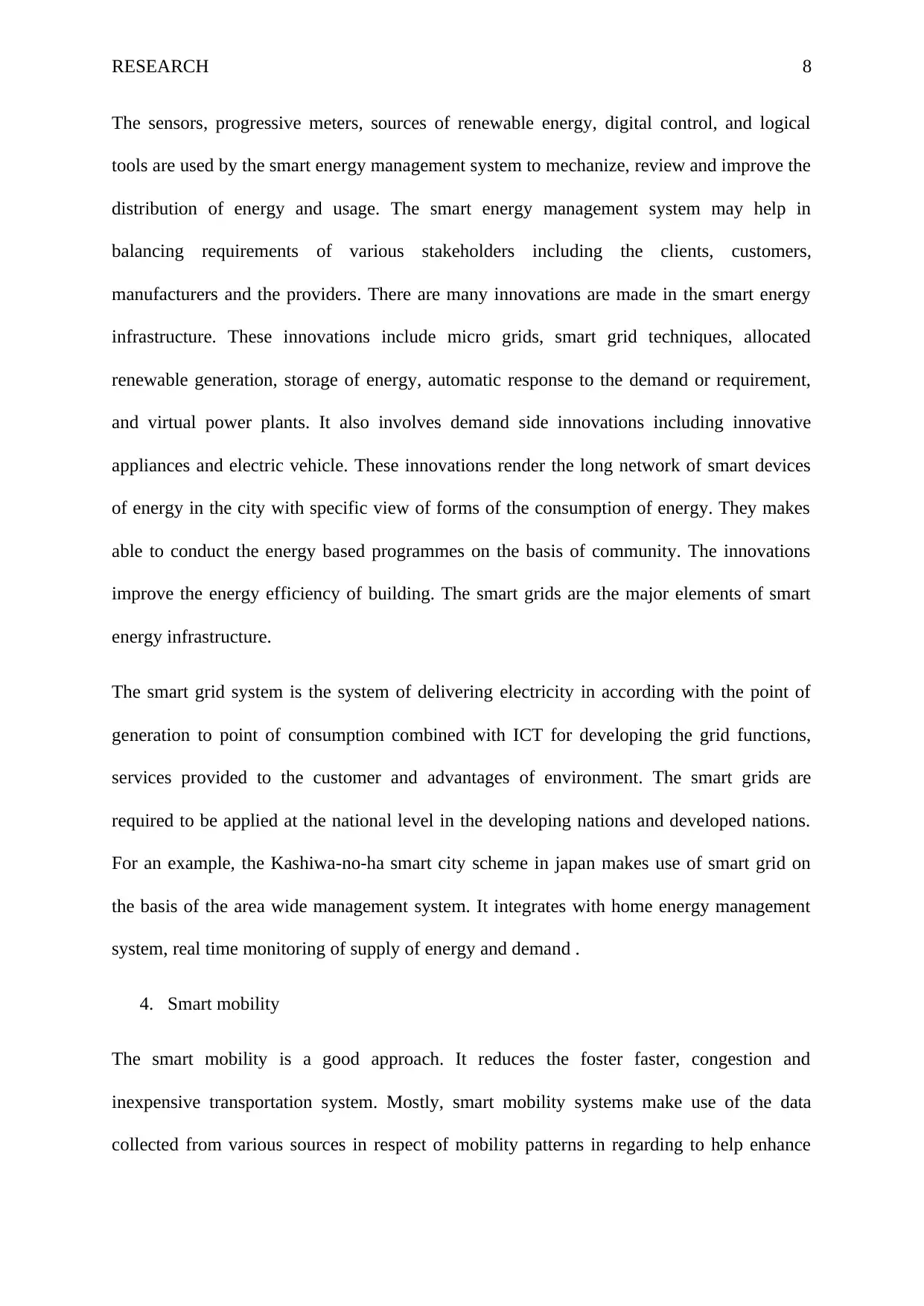
RESEARCH 8
The sensors, progressive meters, sources of renewable energy, digital control, and logical
tools are used by the smart energy management system to mechanize, review and improve the
distribution of energy and usage. The smart energy management system may help in
balancing requirements of various stakeholders including the clients, customers,
manufacturers and the providers. There are many innovations are made in the smart energy
infrastructure. These innovations include micro grids, smart grid techniques, allocated
renewable generation, storage of energy, automatic response to the demand or requirement,
and virtual power plants. It also involves demand side innovations including innovative
appliances and electric vehicle. These innovations render the long network of smart devices
of energy in the city with specific view of forms of the consumption of energy. They makes
able to conduct the energy based programmes on the basis of community. The innovations
improve the energy efficiency of building. The smart grids are the major elements of smart
energy infrastructure.
The smart grid system is the system of delivering electricity in according with the point of
generation to point of consumption combined with ICT for developing the grid functions,
services provided to the customer and advantages of environment. The smart grids are
required to be applied at the national level in the developing nations and developed nations.
For an example, the Kashiwa-no-ha smart city scheme in japan makes use of smart grid on
the basis of the area wide management system. It integrates with home energy management
system, real time monitoring of supply of energy and demand .
4. Smart mobility
The smart mobility is a good approach. It reduces the foster faster, congestion and
inexpensive transportation system. Mostly, smart mobility systems make use of the data
collected from various sources in respect of mobility patterns in regarding to help enhance
The sensors, progressive meters, sources of renewable energy, digital control, and logical
tools are used by the smart energy management system to mechanize, review and improve the
distribution of energy and usage. The smart energy management system may help in
balancing requirements of various stakeholders including the clients, customers,
manufacturers and the providers. There are many innovations are made in the smart energy
infrastructure. These innovations include micro grids, smart grid techniques, allocated
renewable generation, storage of energy, automatic response to the demand or requirement,
and virtual power plants. It also involves demand side innovations including innovative
appliances and electric vehicle. These innovations render the long network of smart devices
of energy in the city with specific view of forms of the consumption of energy. They makes
able to conduct the energy based programmes on the basis of community. The innovations
improve the energy efficiency of building. The smart grids are the major elements of smart
energy infrastructure.
The smart grid system is the system of delivering electricity in according with the point of
generation to point of consumption combined with ICT for developing the grid functions,
services provided to the customer and advantages of environment. The smart grids are
required to be applied at the national level in the developing nations and developed nations.
For an example, the Kashiwa-no-ha smart city scheme in japan makes use of smart grid on
the basis of the area wide management system. It integrates with home energy management
system, real time monitoring of supply of energy and demand .
4. Smart mobility
The smart mobility is a good approach. It reduces the foster faster, congestion and
inexpensive transportation system. Mostly, smart mobility systems make use of the data
collected from various sources in respect of mobility patterns in regarding to help enhance
⊘ This is a preview!⊘
Do you want full access?
Subscribe today to unlock all pages.

Trusted by 1+ million students worldwide
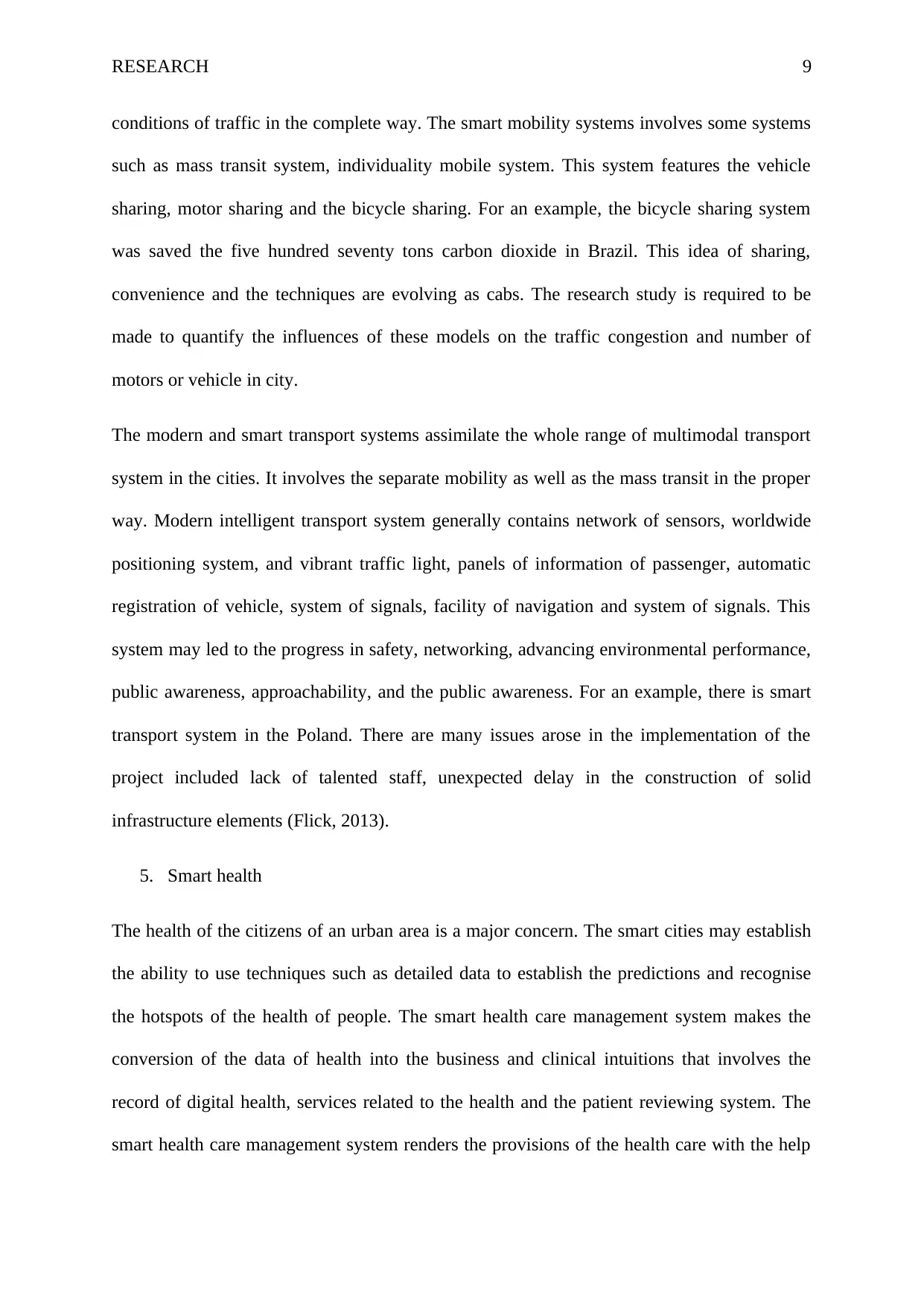
RESEARCH 9
conditions of traffic in the complete way. The smart mobility systems involves some systems
such as mass transit system, individuality mobile system. This system features the vehicle
sharing, motor sharing and the bicycle sharing. For an example, the bicycle sharing system
was saved the five hundred seventy tons carbon dioxide in Brazil. This idea of sharing,
convenience and the techniques are evolving as cabs. The research study is required to be
made to quantify the influences of these models on the traffic congestion and number of
motors or vehicle in city.
The modern and smart transport systems assimilate the whole range of multimodal transport
system in the cities. It involves the separate mobility as well as the mass transit in the proper
way. Modern intelligent transport system generally contains network of sensors, worldwide
positioning system, and vibrant traffic light, panels of information of passenger, automatic
registration of vehicle, system of signals, facility of navigation and system of signals. This
system may led to the progress in safety, networking, advancing environmental performance,
public awareness, approachability, and the public awareness. For an example, there is smart
transport system in the Poland. There are many issues arose in the implementation of the
project included lack of talented staff, unexpected delay in the construction of solid
infrastructure elements (Flick, 2013).
5. Smart health
The health of the citizens of an urban area is a major concern. The smart cities may establish
the ability to use techniques such as detailed data to establish the predictions and recognise
the hotspots of the health of people. The smart health care management system makes the
conversion of the data of health into the business and clinical intuitions that involves the
record of digital health, services related to the health and the patient reviewing system. The
smart health care management system renders the provisions of the health care with the help
conditions of traffic in the complete way. The smart mobility systems involves some systems
such as mass transit system, individuality mobile system. This system features the vehicle
sharing, motor sharing and the bicycle sharing. For an example, the bicycle sharing system
was saved the five hundred seventy tons carbon dioxide in Brazil. This idea of sharing,
convenience and the techniques are evolving as cabs. The research study is required to be
made to quantify the influences of these models on the traffic congestion and number of
motors or vehicle in city.
The modern and smart transport systems assimilate the whole range of multimodal transport
system in the cities. It involves the separate mobility as well as the mass transit in the proper
way. Modern intelligent transport system generally contains network of sensors, worldwide
positioning system, and vibrant traffic light, panels of information of passenger, automatic
registration of vehicle, system of signals, facility of navigation and system of signals. This
system may led to the progress in safety, networking, advancing environmental performance,
public awareness, approachability, and the public awareness. For an example, there is smart
transport system in the Poland. There are many issues arose in the implementation of the
project included lack of talented staff, unexpected delay in the construction of solid
infrastructure elements (Flick, 2013).
5. Smart health
The health of the citizens of an urban area is a major concern. The smart cities may establish
the ability to use techniques such as detailed data to establish the predictions and recognise
the hotspots of the health of people. The smart health care management system makes the
conversion of the data of health into the business and clinical intuitions that involves the
record of digital health, services related to the health and the patient reviewing system. The
smart health care management system renders the provisions of the health care with the help
Paraphrase This Document
Need a fresh take? Get an instant paraphrase of this document with our AI Paraphraser
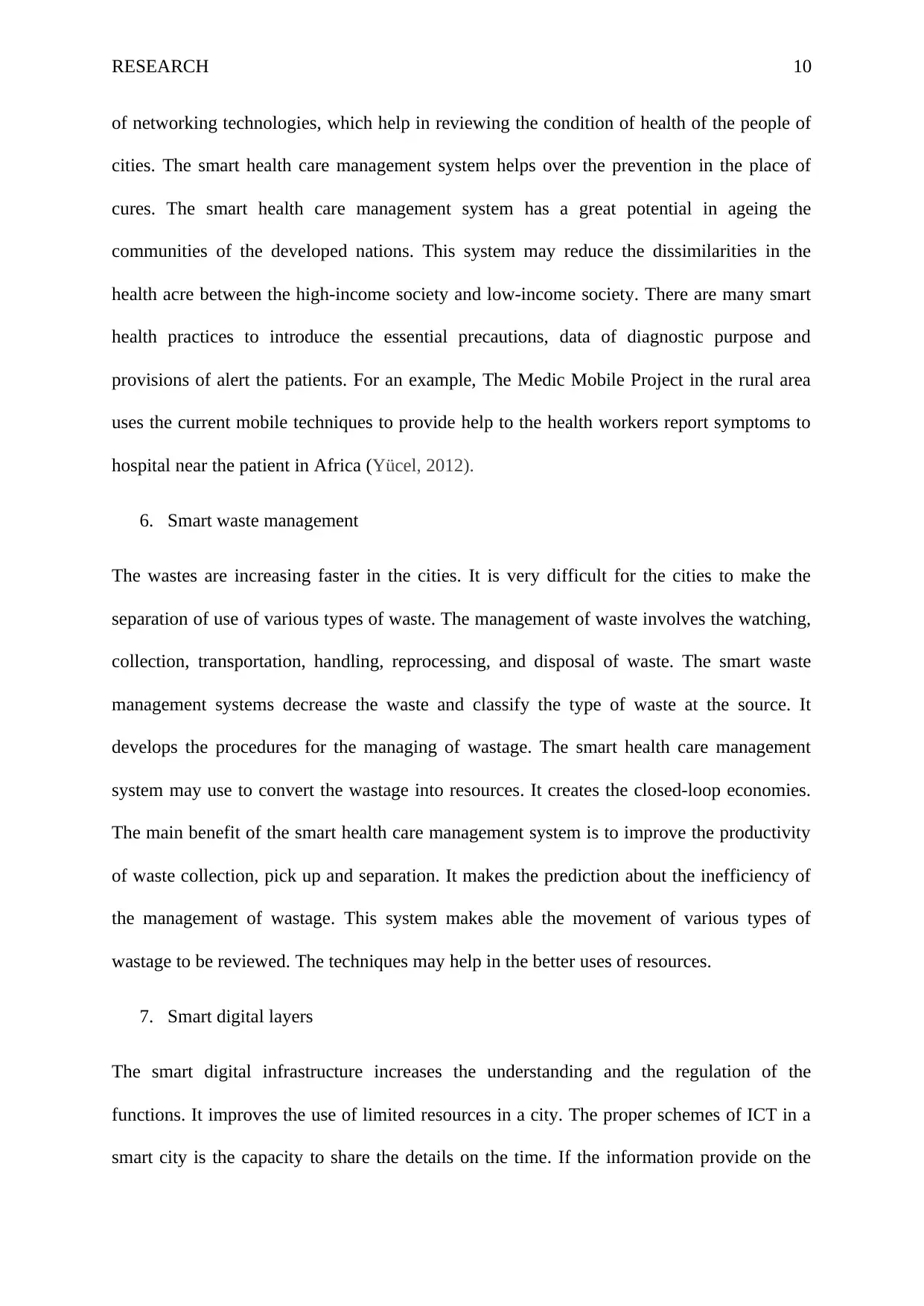
RESEARCH 10
of networking technologies, which help in reviewing the condition of health of the people of
cities. The smart health care management system helps over the prevention in the place of
cures. The smart health care management system has a great potential in ageing the
communities of the developed nations. This system may reduce the dissimilarities in the
health acre between the high-income society and low-income society. There are many smart
health practices to introduce the essential precautions, data of diagnostic purpose and
provisions of alert the patients. For an example, The Medic Mobile Project in the rural area
uses the current mobile techniques to provide help to the health workers report symptoms to
hospital near the patient in Africa (Yücel, 2012).
6. Smart waste management
The wastes are increasing faster in the cities. It is very difficult for the cities to make the
separation of use of various types of waste. The management of waste involves the watching,
collection, transportation, handling, reprocessing, and disposal of waste. The smart waste
management systems decrease the waste and classify the type of waste at the source. It
develops the procedures for the managing of wastage. The smart health care management
system may use to convert the wastage into resources. It creates the closed-loop economies.
The main benefit of the smart health care management system is to improve the productivity
of waste collection, pick up and separation. It makes the prediction about the inefficiency of
the management of wastage. This system makes able the movement of various types of
wastage to be reviewed. The techniques may help in the better uses of resources.
7. Smart digital layers
The smart digital infrastructure increases the understanding and the regulation of the
functions. It improves the use of limited resources in a city. The proper schemes of ICT in a
smart city is the capacity to share the details on the time. If the information provide on the
of networking technologies, which help in reviewing the condition of health of the people of
cities. The smart health care management system helps over the prevention in the place of
cures. The smart health care management system has a great potential in ageing the
communities of the developed nations. This system may reduce the dissimilarities in the
health acre between the high-income society and low-income society. There are many smart
health practices to introduce the essential precautions, data of diagnostic purpose and
provisions of alert the patients. For an example, The Medic Mobile Project in the rural area
uses the current mobile techniques to provide help to the health workers report symptoms to
hospital near the patient in Africa (Yücel, 2012).
6. Smart waste management
The wastes are increasing faster in the cities. It is very difficult for the cities to make the
separation of use of various types of waste. The management of waste involves the watching,
collection, transportation, handling, reprocessing, and disposal of waste. The smart waste
management systems decrease the waste and classify the type of waste at the source. It
develops the procedures for the managing of wastage. The smart health care management
system may use to convert the wastage into resources. It creates the closed-loop economies.
The main benefit of the smart health care management system is to improve the productivity
of waste collection, pick up and separation. It makes the prediction about the inefficiency of
the management of wastage. This system makes able the movement of various types of
wastage to be reviewed. The techniques may help in the better uses of resources.
7. Smart digital layers
The smart digital infrastructure increases the understanding and the regulation of the
functions. It improves the use of limited resources in a city. The proper schemes of ICT in a
smart city is the capacity to share the details on the time. If the information provide on the
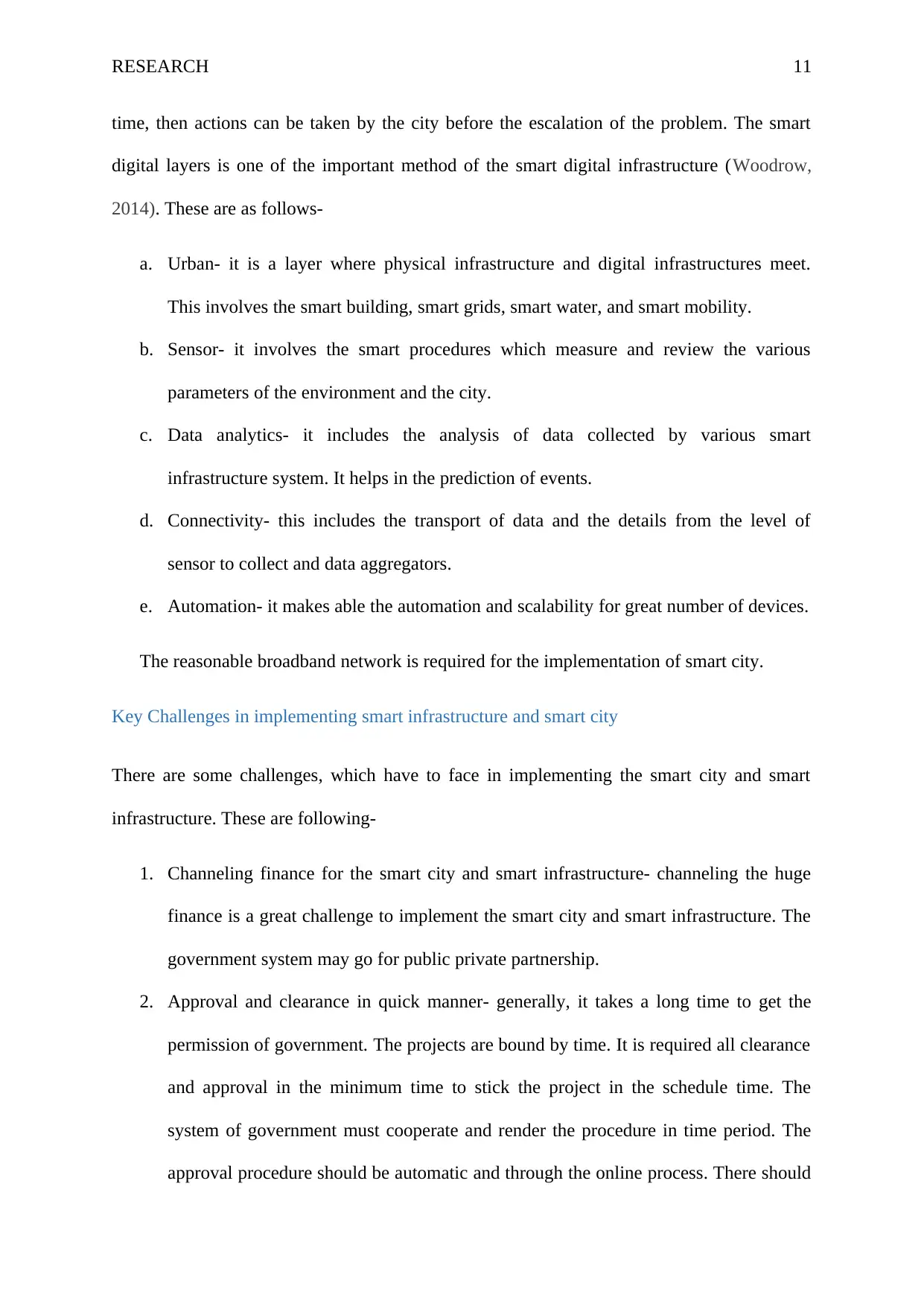
RESEARCH 11
time, then actions can be taken by the city before the escalation of the problem. The smart
digital layers is one of the important method of the smart digital infrastructure (Woodrow,
2014). These are as follows-
a. Urban- it is a layer where physical infrastructure and digital infrastructures meet.
This involves the smart building, smart grids, smart water, and smart mobility.
b. Sensor- it involves the smart procedures which measure and review the various
parameters of the environment and the city.
c. Data analytics- it includes the analysis of data collected by various smart
infrastructure system. It helps in the prediction of events.
d. Connectivity- this includes the transport of data and the details from the level of
sensor to collect and data aggregators.
e. Automation- it makes able the automation and scalability for great number of devices.
The reasonable broadband network is required for the implementation of smart city.
Key Challenges in implementing smart infrastructure and smart city
There are some challenges, which have to face in implementing the smart city and smart
infrastructure. These are following-
1. Channeling finance for the smart city and smart infrastructure- channeling the huge
finance is a great challenge to implement the smart city and smart infrastructure. The
government system may go for public private partnership.
2. Approval and clearance in quick manner- generally, it takes a long time to get the
permission of government. The projects are bound by time. It is required all clearance
and approval in the minimum time to stick the project in the schedule time. The
system of government must cooperate and render the procedure in time period. The
approval procedure should be automatic and through the online process. There should
time, then actions can be taken by the city before the escalation of the problem. The smart
digital layers is one of the important method of the smart digital infrastructure (Woodrow,
2014). These are as follows-
a. Urban- it is a layer where physical infrastructure and digital infrastructures meet.
This involves the smart building, smart grids, smart water, and smart mobility.
b. Sensor- it involves the smart procedures which measure and review the various
parameters of the environment and the city.
c. Data analytics- it includes the analysis of data collected by various smart
infrastructure system. It helps in the prediction of events.
d. Connectivity- this includes the transport of data and the details from the level of
sensor to collect and data aggregators.
e. Automation- it makes able the automation and scalability for great number of devices.
The reasonable broadband network is required for the implementation of smart city.
Key Challenges in implementing smart infrastructure and smart city
There are some challenges, which have to face in implementing the smart city and smart
infrastructure. These are following-
1. Channeling finance for the smart city and smart infrastructure- channeling the huge
finance is a great challenge to implement the smart city and smart infrastructure. The
government system may go for public private partnership.
2. Approval and clearance in quick manner- generally, it takes a long time to get the
permission of government. The projects are bound by time. It is required all clearance
and approval in the minimum time to stick the project in the schedule time. The
system of government must cooperate and render the procedure in time period. The
approval procedure should be automatic and through the online process. There should
⊘ This is a preview!⊘
Do you want full access?
Subscribe today to unlock all pages.

Trusted by 1+ million students worldwide
1 out of 22
Related Documents
Your All-in-One AI-Powered Toolkit for Academic Success.
+13062052269
info@desklib.com
Available 24*7 on WhatsApp / Email
![[object Object]](/_next/static/media/star-bottom.7253800d.svg)
Unlock your academic potential
Copyright © 2020–2025 A2Z Services. All Rights Reserved. Developed and managed by ZUCOL.





